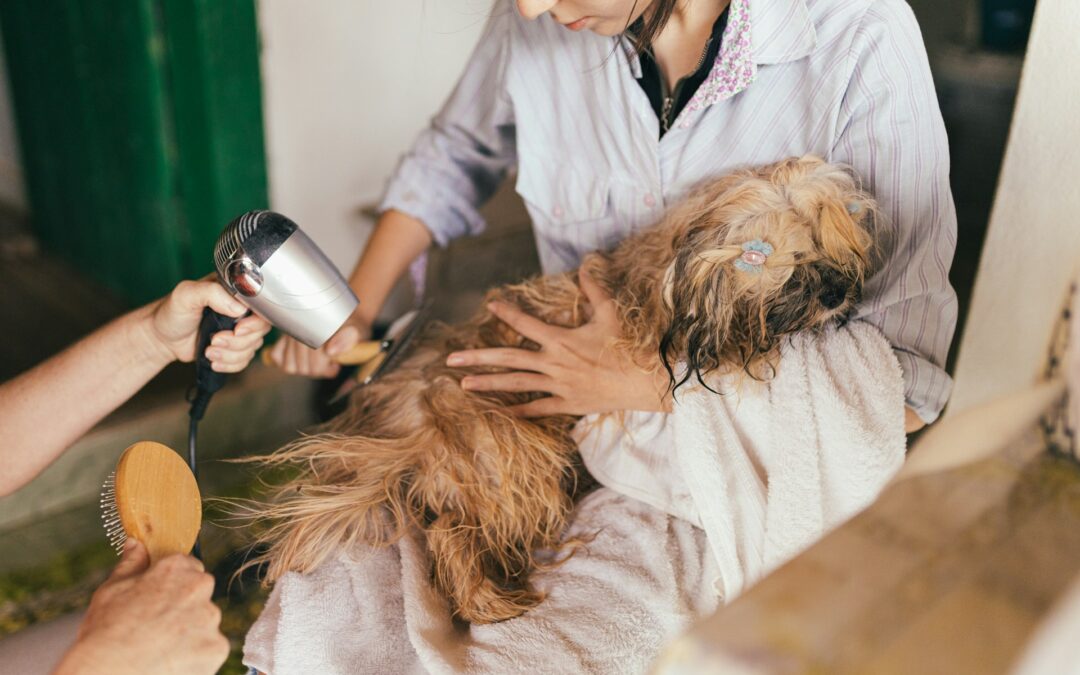Grooming should be a relaxing part of your dog’s routine, but for some pet parents, it turns into a struggle when their dog reacts by biting. This behavior often leaves owners feeling frustrated or helpless, especially if it happens regularly. You’re not alone if grooming has become a challenge. Understanding why your dog is reacting this way is the first step to making the process smoother and safer for everyone involved.
Biting doesn’t always mean aggression. Sometimes it’s your dog’s way of saying, “I’m scared,” or “That hurts.” For dogs living in Tampa or other parts of South Florida, grooming is necessary year-round to stay clean and comfortable in the warm, humid weather. So if your pup isn’t a fan of bath time or nail clipping, learning what drives their reaction and how to respond can really improve the experience for both of you.
Common Triggers For Biting During Grooming
Dogs may bite during grooming for lots of reasons, but most of them come from fear, pain, or discomfort. Knowing what’s behind the behavior can help you figure out what to watch for and how to handle it.
Here are some common triggers:
- Fear of strange equipment like clippers or blow dryers
- Anxiety when being handled or restrained
- Pain from matting or sensitive skin
- Discomfort from past bad grooming experiences
- Sensitivity in certain areas like the paws, tail, or ears
Many dogs who haven’t been groomed regularly or who didn’t grow up getting used to grooming are more likely to be reactive. For example, a dog who had a painful ear infection once might never forget that sensation and may snap when someone touches their ears again. Like people, dogs can hold onto unpleasant memories and become protective when they feel something is about to repeat.
If your dog starts to stiffen, growl, or snap when you’re grooming them, see it as a warning light rather than a discipline issue. These cues are usually signs that your dog is overwhelmed or uncomfortable. Recognizing early signs like staring, tucked tails, or lip licking can help you pause before the behavior escalates into biting.
Preventive Measures To Reduce Biting
Helping your dog become more comfortable during grooming takes time and patience. The best results usually come from a mix of awareness, preparation, and making the experience feel rewarding instead of scary. Start by gradually getting your dog comfortable with being handled and using grooming tools around them without actually using them right away.
Here’s a simple plan you can follow to lower the risk of biting:
1. Let your dog sniff and explore the grooming tools while in a relaxed setting.
2. Reward calm behavior with praise or treats during handling.
3. Keep sessions short at first, focusing on one body part like the paw or ear.
4. Use calming gear like anxiety wraps if your dog responds well to them.
5. Try dog-friendly scents or ambient noise for a more relaxing environment.
6. Avoid forcing any part of the process. If your dog resists, back off and try again later.
7. Stick to a regular grooming schedule so it becomes routine and predictable.
If your grooming space is too busy or loud, that can also stress your dog out. Try choosing a calm room with minimal distractions. Over time, these small changes can help your dog feel more safe and in control. Eventually, they’ll build positive associations with grooming, which makes the process easier on everyone.
Techniques For Safe And Effective Grooming
Some dogs get defensive right when they see grooming tools. If your dog tends to nip or bite, using the right techniques can make a big difference. You don’t need to do anything overly complicated. Just adjust how you approach the situation to keep it calm and controlled. Safety should always come first for both you and your pet.
It’s helpful to use equipment made with comfort in mind. Choose brushes that are gentle on the skin and clippers that run quietly. That alone can help ease nervous dogs. Make sure your dog is on a stable surface where they won’t slip. When you hold them, don’t grip too tight, but offer enough support so they feel secure. Some groomers use safety loops or stands, but if you’re doing light brushing at home between appointments, just focus on calm body language and gentle touch.
There are also cases where a muzzle might be the safest option. A basket muzzle can allow your dog to breathe and pant while preventing biting. It’s not a punishment. It’s just a tool to keep everyone safe during a stressful moment. The key is not to spring it on your dog. Let them sniff it and get used to it first. And always reward them afterward so they don’t associate it with fear.
If your dog bites suddenly when touched in a sore spot or even just panics at the sight of a nail trimmer, try breaking tasks into smaller steps. One day could just mean running the trimmer close to them without cutting. The next day, give them treats when it comes near their paw. Go slowly. These small wins go a long way in building trust.
When To Reach Out To A Local Dog Groomer
If grooming your dog is starting to feel like a fight every time, it might be time to get help from a local dog groomer. Professional groomers often have experience with different behavior types and can spot signs you might miss under stress. In places like Tampa, where it’s hot most of the year, regular grooming isn’t just about looks. It’s about keeping your dog comfy and avoiding things like skin issues or matting.
A local dog groomer can also create a plan that works best for your particular dog. Some pets do better in quiet, one-on-one settings. Others may need shorter but more frequent sessions. Groomers can often make those adjustments. They’ll also know safe ways to handle your dog’s triggers, keeping both the groomer and your dog protected.
A mobile grooming service can be especially helpful for dogs that act out during grooming. It brings the process into a familiar space, your home. For many reactive dogs, removing the noisy salon environment can be a big help. It’s less distracting, less chaotic, and removes a large piece of the stress.
If you’ve tried different techniques and your dog still bites during grooming, don’t write it off as something you just have to deal with. A good local dog groomer can give you support, come up with a plan, and help you approach grooming with more confidence and less frustration.
Making Grooming A Positive Part Of Your Dog’s Routine
Building trust is what turns grooming from a battle into something easier for both of you. Dogs remember how they felt during past sessions, so it’s important to end each one on a good note. Don’t rush things, and don’t forget to celebrate progress, even if it’s small. If your dog let you brush them for five minutes without drama, that’s a win.
Use rewards to give your dog something to look forward to. This could be praise, a favorite treat, or even a short walk afterward. What matters most is helping your dog see that good things follow grooming time. You could even make it a predictable part of their routine by brushing on the same day each week.
One of the best things about keeping up with grooming is the long-term comfort it brings. Dogs like routine. When they know what to expect and the process doesn’t cause pain or fear, they respond better. Over time, even dogs that used to bite might stop showing the same resistance.
It also helps if you build your own routine at home that pairs with the visits to your local dog groomer. This mix of minor upkeep and professional care helps your dog stay fresh, clean, and calm all year long.
Grooming Tips That Work With Florida’s Weather
Living in Tampa means warm temps and lots of humidity, which affects more than just your comfort. It affects your dog’s, too. Dogs in this climate often shed more, sweat through their paws, and are at higher risk for hot spots. That’s where keeping up with grooming plays an even bigger role.
Here’s how to tailor your dog’s grooming to Florida weather:
- Bathe your dog more frequently in the summer to rinse off sweat, salt, or sand
- Keep hair neatly trimmed to avoid overheating, but don’t shave the coat too close, as it offers protection from the sun
- Brush weekly to remove loose fur and help with airflow through the coat
- Check their paws after walks since hot pavement and grass hiding burrs can hurt padding
- Try grooming sessions early in the morning or after sunset to prevent overheating
A regular schedule with your local dog groomer helps keep things on track, especially if your pet deals with allergies or skin sensitivities. Grooming in a cool, calm place on a routine basis can prevent physical discomfort and make your dog more relaxed each time.
Helping Your Dog Feel Safe Again
Biting during grooming happens for many different reasons, but it doesn’t have to be the norm. Understanding your dog’s stress signals, working with them gradually, and choosing grooming tools and environments that make them feel secure can help shift the experience from scary to manageable.
In warm, busy areas like Tampa, keeping your dog groomed isn’t just about cleanliness. It’s about making sure they stay healthy, happy, and comfortable all year long. When local pet parents team up with the right support, even the most nervous dogs can begin to trust again. It just takes the right mix of patience, plan, and care.
For those seeking a bit of extra help with a reactive dog, relying on a trusted local dog groomer can make a big difference. At Honey Pets, we bring professional grooming right to your doorstep, creating a calm and familiar environment that helps your pet stay relaxed. If you’re ready to explore how this can make grooming stress-free for both you and your furry friend, we’d love to help.

